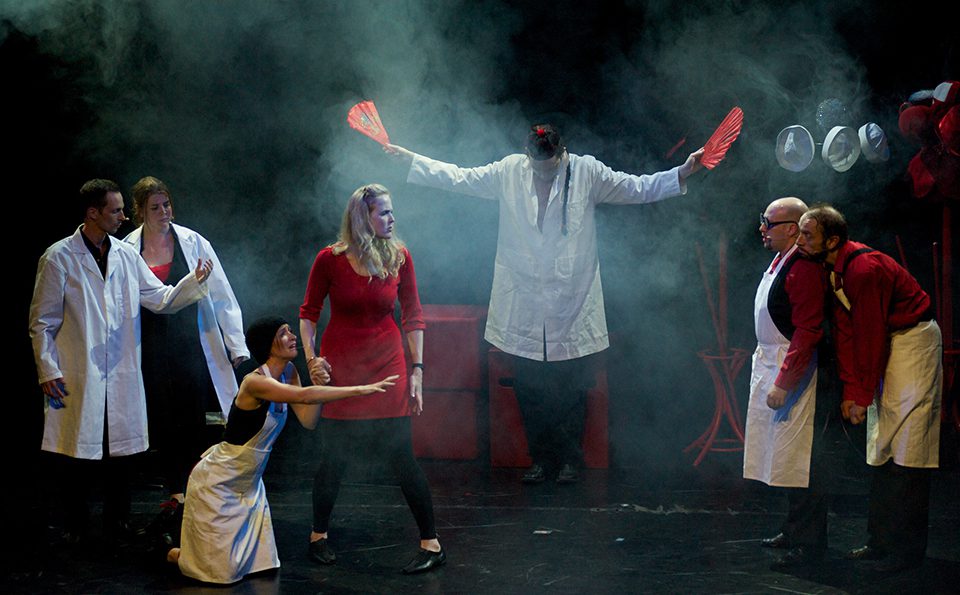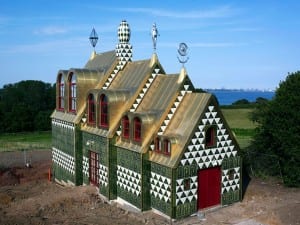Improvisational theatre and performance has experienced widespread popularity on TV and radio, but to what extent do props and visuals inform live performance
Improvised theatre is a limited art form. Performances are determined by the interaction between actors and the speed of their imaginations. In practice, a group’s dynamic and experience provide endless material, but the limitations for visuals and props create another schism within this paradigm. Some troupes and creative figureheads have tried to remedy this with elaborate set-ups and themed shows, achieving varying degrees of success. However, by doing so, are these performances compromising the very nature of improvisation (impro) in the first place.
Modern improvisational theatre developed separately in Britain and America. Viola Spolin’s theatre games gave rise to The Second City in Chicago, which started its revue performances in 1959. Thereafter, Keith Johnstone’s London-based group, The Theatre Machine, informed his creation of the competitive form Theatresports in 1977, whereby teams compete for dramatic effect. Johnstone based this form of improvisational theatre on techniques that he observed in professional wrestling to create audience reaction. Both Spolin and Johnstone migrated to Canada; Johnstone relocating to Calgary and The Second City establishing its Toronto venue in 1973. The key difference between doctrines is the connectivity of scenes. The British school (short form) consists of largely isolated scenes, while the American preference is the underlying narrative (long form). Either format can include props, costumes and sets, but the use of such aids is more practical to implement in long form shows.
Most people know of improvisation primarily through radio and television. BBC Radio Four’s Just A Minute and I’m Sorry I Haven’t A Clue are staples of the medium, because they fit the mould dictated by classical theatre. There’s a clear advantage to radio for improvisation; all the visuals originate in the listener’s imagination, and therefore, there’s no need to make them concrete. TV formats such as Whose Line Is It Anyway? have kept mostly to minimal visual arrangement, using mime and music. SCTV was the most notable deviation, as content was based on Second City Toronto’s pre-existing stage improvisations and sketches, and as such, the production design was predetermined.
While practitioners continue the search for inexpensive and accessible outlets, ironically it’s the theatre with its codes of practice that differ from the idea of improvisation, which is hosting the resurgence. The addition of specific props, costumes and sets gives the impression of a more elaborate show. The possible benefits must be weighed against the risk of limiting the performers. Considering this, should we be moving towards aesthetics of improvisation, in short, a prescriptive model for the use of visual elements in impro shows?
The main drawback associated with using props is their limited capacity, for example, they can only be objects of a certain type (if not their actual function i.e. a foam hand, beach ball, etc.), thus restricting the extent of performers’ actions. Dylan Emery, co-founder of UK groups Showstopper: The Improvised Musical and Grand Theft Impro, suggests: “There isn’t a steadfast rule about how sets and props affect performers. Some performers use props for what they actually are, and it limits their mime and imaginations; while others thrive. Some love real locations, others find it restrictive; while some others just endow the set with the additional elements they need.” The effect is determined by the type of performer and their skill level. When characterising the manifestation of players’ levels, Emery argues: “The only general guide is that less experienced performers will find it easier to use props and sets for their literal meaning.”
Performers use props in a myriad of ways, but can these aids limit the show’s overall appeal? Props may distract audiences, and style can overtake content. Sandy Jobin-Bevans, Director of Second City Toronto’s main-stage, speaks candidly about his method for incorporating visuals: “The best impro moments happen with ‘found items’. Nothing planned, just found backstage or lying around the venue. We did a show in a venue that was also showing Oklahoma, so there were several scenes that were about farms and hay. It was definitely a source of scenic inspiration.” This “found art” method is an organic approach to constructing a show. If scenes are based on specific items, which happen to be present, there’s no concern for having artificially constructed anything in advance. Jobin-Bevans warns of the effect of pre-thinking implementation: “Almost anything predetermined in impro is negative. It can be restrictive when you’re trying to stick to any kind of ‘plan’ and I’d try to avoid it altogether.” So, if something is naturally present, then its use should be natural too. The virtue of this approach is that both finding and using objects is intuitive.
Whether or not groups have been drifting away from this thinking is a point of contention. Steve Roe, producer of London-based Hoopla Presents…, argues for the use of visual elements, as long as they don’t affect the content of scenes: “I’ve been putting more visuals in shows. However, they are used in-between scenes rather than in the scenes. The rule of thumb is, if you’re going to put something on stage you might as well make it look good, but without distracting audiences away from the actors.” While Roe is more receptive to this type of experimentation, he is quick to point out that mixing the real and unreal can have negative consequences: “I don’t like using props because I find any ‘real’ thing that you bring to the stage, effectively removes the reality of the mimed things that have already been added. For instance, carrying in a real saucepan would remove the power of the mimed kitchen sink.”
A collective’s visual identity – including signature objects, can also constitute a predetermined visual element. Jobin-Bevans does not notice a trend towards North American groups having a defined visual scheme. However, Emery sees a more localised pattern: “I don’t know if it’s national, but in and around London, some of the more ambitious troupes have created a defined look. For example, Showstopper is red and black with props all red and black, The Noise Next Door also wear black shirts and coloured ties, while The Scat Pack wear black and yellow.” Roe believes that the recent rise in popularity of these groups is linked to this approach: “It’s not an accident that Showstopper, The Scat Pack and Noise Next Door took off in 2010, they were also the best dressed and had a subtle approach, giving the performances a professional touch.”
A new trend towards the signature uniform is emerging. If pre-selected props, costumes and sets for specific shows are not adding value, elements that are carefully selected which have no attached value and meaning are bringing a new dynamic to this type of performance. Emery believes that the effect of a uniform on performers is a matter of group psychology: “Impro, especially short-form comedy is a sport as much as it is an art form, so having a uniform can help bind the group together, give it a sense of professionalism and drive. But it can also have no effect whatsoever; it won’t make an unfocused performer any better on stage.” However, Emery is not convinced that the different lines of thought have a solid basis: “The only tendency I’ve noticed is that the school of improvisers who think doing good impro is about tapping into individual whimsical genius are more likely to mistrust the idea of uniforms; similarly, uniformed troupes can think that people looking unkempt is indicative of a sloppy performance. Neither stereotype holds true in my experience.”
There are distinct ideologies within the (apparently limited) circle, and these form the basis of how visuals are adopted, if at all. The idea of entirely dismissing visual aids is one school of thought, but some troupes reject the uniform in favour of no colour at all. Jobin-Bevans champions this approach: “All blacks or neutrals as they are called at Second City, allow for multiple characters to be played without the idea of costumes coming into play.”
Without visual variation, the diversity of performance reaches its zenith through unyielding improvisation. It is confounded in the common writers’ maxim: restrictions are liberating. The aesthetics of improvisation is a contradiction. Stripped of any concrete visuals, everything is left to the imagination. It’s unclear whether within this idea, it’s possible to advance the art form, or if it’s even desirable. One advantage is clear; this kind of theatrical improvisation has the same benefit as its radio counterpart. If the performers see something, and can communicate it, the audience will see it too.
Visit www.secondcity.com and www.keithjohnstone.com.
Jules Garnett





